#mythtober2022
Explore tagged Tumblr posts
Text
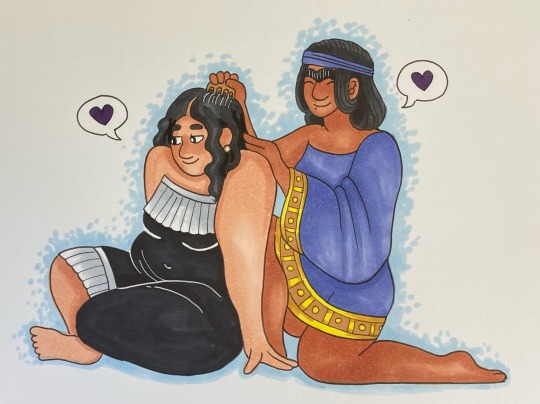
Day 25 & 26: Geshtinanna & Geshtindudu, Divine Girlfriends
Geshtinanna is most well known for being Dumuzids sister, and involved in the myths involving his death. In some of these myths it is either implied or directly stated that after Dumuzid is trapped in the underworld, she offers to take his place for part of the year. She is thought to serve as the scribe of Ereshkigal, also going by the name Belet-seri. (Akkadian)
There are a few attested spouses of Geshtinna (Namely Ningishzida and Amurru/Martu) but alternative traditions exist for both of them which is why I made my version of her unmarried.
Not much is known about Geshtindudu aside from her being Geshtinannas “advisor and girlfriend”. I like the idea of them being romantically involved, but my version of Geshtinanna is Asexual, so I decided they would be in an Ace relationship.
#inktober2022#mythtober2022#annunaki#I also support the interpretation where they are straight up lesbians#coincidentally it is Ace week this week#I’m going to pretend I timed that
65 notes
·
View notes
Text
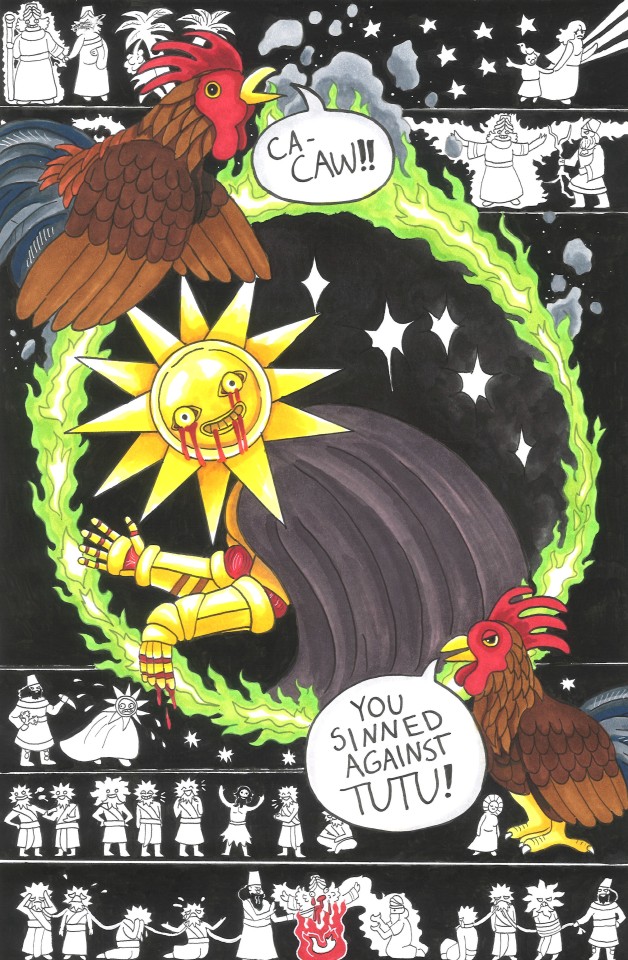
Final day: Enmesharra The Calamity King
Enmesharra was among the ancestors of Enlil, an older generation of gods, and appears in myths commonly as an antagonistic figure. In one he contends with Marduk (With Nergal as a jailer) in another with Enlil. In some of these he is killed (put to the sword or burned) but in one, his children the Sebbitti (2and to bottom panel) are beheaded in his place, and he escapes. I like the idea that he represents a sort of “primordial chaos” that contends with Enlil’s order.
He is described as having a “spleandor”/radiance which is taken from him and given to Shamash in one of his executions. (Bottom panel)
A lot of my characterization of him comes from a game of DND that me and some of my friends played, where he was a flayed man in a gold suit as a result of his execution.
49 notes
·
View notes
Text
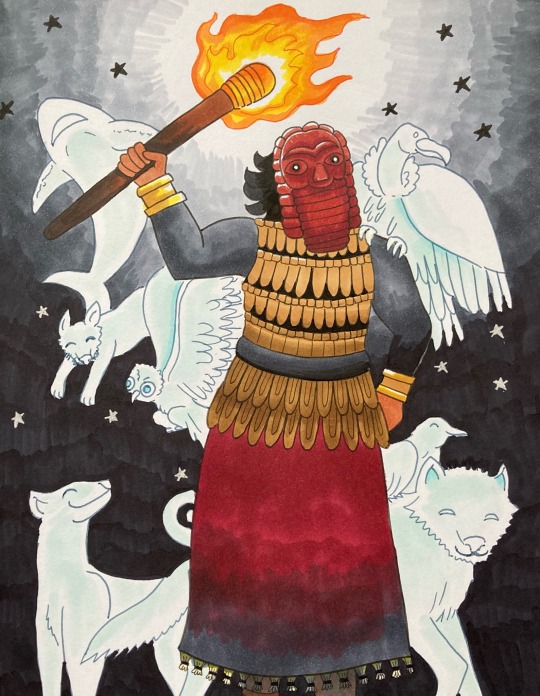
Day 18: Hendursaga
A “divine night watchman” whose primary function was to protect people traveling through the city at night. He was equated with Ishum (Nergal’s Sukkal), hence why mine is just Ishum wearing a mask. (This is what he gets up too when he’s not keeping Nergal from destroying the world I guess) His primary area of worship was Lagash.
One Sumerian source states that he had three heptads of servants, one of which could be connected to the Sebitti, with each member being associated with an animal. Unknown if they are animals or human/animal hybrids like other protector demons.
Additionally he had a connection with Nashe (day 3) who in a hymn, assigns him his torch.
42 notes
·
View notes
Text
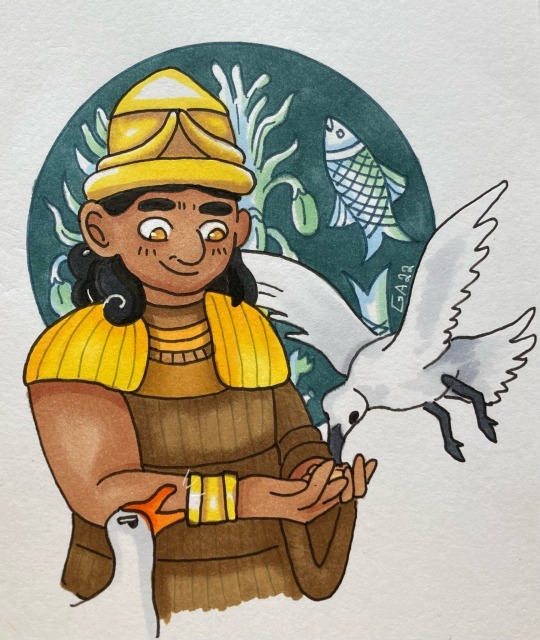
Day 6: Nanshe
The first of the eight deities I’ve been calling the plant gang! (I wrote a bit of my thoughts about them below the cut) in Enki and Ninhursag she is born from Enki’s throat, in other contexts she is also Enki’s daughter, born by Damgalnuna.
Nanshe had many facets to her including being affiliated with birds, wetlands, fish, and justice. One myth posits that she has a beloved favorite bird, maybe a pelican or a goose (it’s not known definitely what it is) I drew a seagull, because as it turns out pelicans are quite hard to draw.
A short intro to “The Plant Gang”:
In most contexts, this set of eight deities cannot be considered as a unified group. Some have associations with each other (Enzag/Inzak was married to Ninsikila/Meskilak) but separate parentages and lineages outside of the following origins are known:
Their names were re-tooled in the myth Enki and Ninhursag taking on different meanings. Near the end of the myth, the god Enki becomes deadly Ill, and Ninhursag relieves him of his pain by “giving birth to” these eight deities from various parts of his body. Their names become basically puns about which part of Enki’s sick body they were pulled from. (i.e. Ninkasi’s name most likely means “mistress of beer” but in the myth it is worked to put emphasis on the ka syllable, meaning mouth, as Ninkasi is born from Enki’s mouth.)
I’m going to try to reconcile both this myths narrative (since it’s well known by Mesopotamian myth standards) as well as their separate cultic contexts with the drawings. We’ll see how that goes!
30 notes
·
View notes
Text

Day 23: Pabilsag
Another malewife, best known for being married to Ninisina. (Day 1!) The tuletary deity of Larak, and also worshipped in Isin and Lagash. He had a variety of characteristics - including medicine, hunting and warfare (due to partial assimilation with Ninurta) and judiciary proceedings.
He was later associated with the constellation Sagittarius, and was thought to have been depicted as a “scorpion tailed archer”, though much earlier iconography supposedly has him as humanoid, dressed as an administrative official. (Unfortunately I haven’t been able to find an actual picture of this, so I had to wing it.)
26 notes
·
View notes
Text
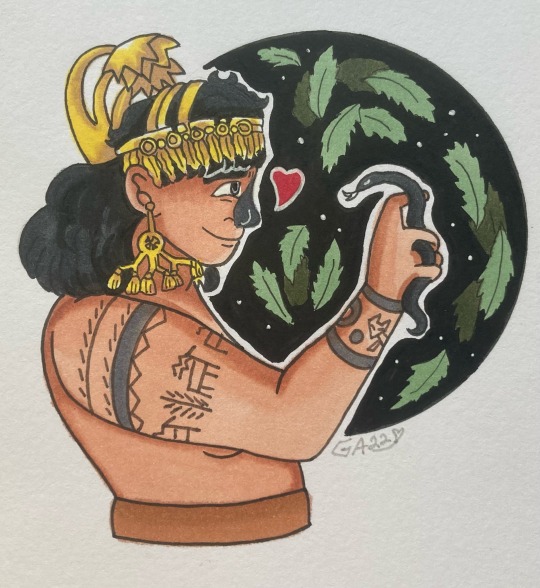
Day 8: Ningiritud
The 3rd member of the plant gang! Her worship was centered in Enegi, where she was considered the wife of Ninazu and the mother of the dying god Ningishzida.
In Enki and Ninhursag she is born from Enki’s nose, so her name is reworked to be “one born from the nose,” as opposed to its original meaning, which likely had to do with hair clasps.
I’ve taken a bunch of liberties with her, giving her tattoos and such, because little about her function is known other than her being Ninazu’s consort (and possibly only in Enegi as well, I don’t think she was associated with him in Eshnunna)
28 notes
·
View notes
Text

Day 16 & 17, Lisin and Asalluhi
These two were drawn together, though they don’t have any association besides having the same mom (Ninhursag)
Lisin:
One of several deities to have a change of gender, being reguarded initially as female and then later male (not universally, some places they were still considered female) hence I thought it would be cool to have their gender be ambiguous. Lisin’s father is Sul-pa-e (to be drawn soon!)
Their character is little known - early on they had associations with various offering goods - minerals, gazelle horns, and medicinal plants, then their male character had an affiliation with fire.
Asalluhi:
I’ve only read a few papers about him, so my info is limited. From what I understand he was the patron god of Kuara associated with divination and having many of the characteristics of his father, Enki. Then at some point he was absorbed into Marduk. I basically consider him “Diet Marduk”.
#annunaki#inktober2022#mythtober2022#ninhursag#missed opportunity to have drawn Lisin and Ashgi together#poor planning I guess
22 notes
·
View notes
Text

Day 12 (I’m behind): Ninkasi
Ninkasi has more modern relevance that the rest of these eight deities - I’ve even been to a place named after her. Her name means “mistress of beer” and she was a goddess of beer and its production. One myth describes her as having a silver and gold cask, and it’s possible depictions of her hold a cup (though to my knowledge no identification of her in iconography is definitive)
In Enki and Ninhursag, she is born from Enki’s mouth. In the ETCSL translation, Ninhursag states that she will be “what satisfies the heart” which I thought was funny considering her functions. Her parentage outside of this myth is by Enki and Ninti, through the Hymn to Ninkasi states that she was raised by Ninhursag.
25 notes
·
View notes
Text
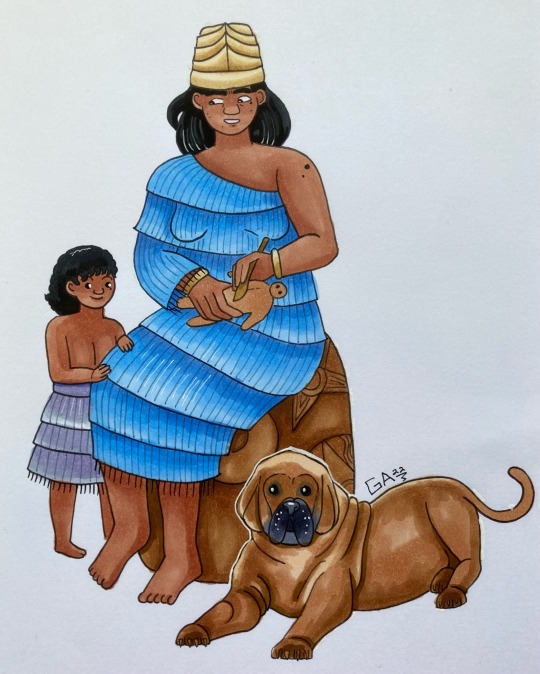
Days 1&2: Double Feature of Ninisina and Damu
The first of the Medicine Deities!
Ninisina was the patron deity of the city of Isin, her name meaning “Mistress of Isin”. She was a medicine and midwife goddess, sharing the symbols of dogs and the scalpel in common with other goddesses with similar functions. Like some of the other medicine goddesses I plan to draw, she became very closely associated with the goddess Gula and eventually became analogous to her. I don’t have a justification for her clothes other than that they are meant to evoke scrubs.
Damu was Ninisinas son (though Gula and Ninkarrak are also potential parents) who also was thought of as a medicine deity, though he additionally was among the dying gods and affiliated with plant life. The story of his early death and journey to the underworld are told by several texts. Him and his mother have a very close bond in the myths, with one hymn referencing how she has taught him how to perform surgery.
22 notes
·
View notes
Text
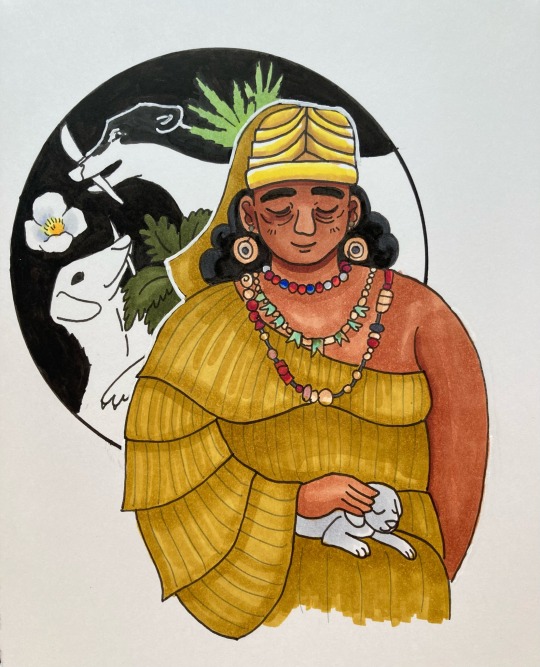
Day 4: Gula the Great
The “chief medicine goddess” who gained great popularity in the pantheon. Her original cult center was Umma, then Nippur became her primary area of worship. Ninurta eventually became reguarded as her spouse, though this wasn’t universal as Bau is his wife in Girsu. Her symbols include dogs, the scalpel and razor, and medicinal herbs.
It is important to note that while the other medicine goddesses I have covered were all eventually closely associated with Gula, they cannot be regarded as epithets or the same goddess as her. Particularly Bau (tomorrow) who had a completely different set of iconography. They developed independently of her and the syncretism happened over time.
28 notes
·
View notes
Text
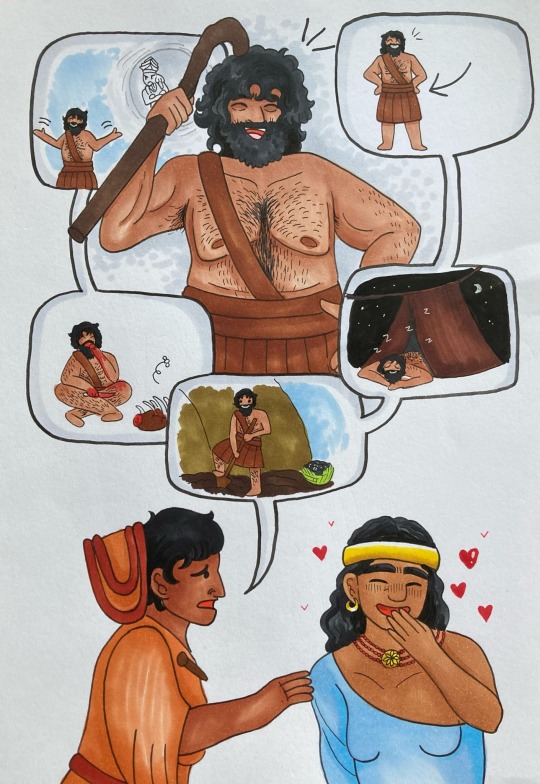
Day 15: Martu
Martu, spelled more often as Amurru, has always been a favorite.
Most of the Google search articles covering him will tell that he was a god of the Amorites, a group of Semitic people who came to settle in many parts of southern Mesopotamia. This isn’t exactly true, the perception now is that he is meant to be a sort of “divine stereotype” of the Amorites, rather than a god originating from their religion. (Fortunately the top google search for him now is @yamayuandadu ‘s wiki article, so hopefully there is more clarity now!)
Foremost he was a god of the steppe, though later he took on other functions. In depictions on cylinder seals he holds a Sheppards cane, and was associated with goats (steppe animal) and mice (probably a dig on the Amorites).
The myth of The Marrige of Martu recalls his want for a spouse and then his subsequent engagement to Adjar-kidug, the daughter of the city god of Inab. (She isn’t his normally attested spouse tbf) Near the end of the myth, his bride to be is having a conversation with her friend, where the friend describes all the downsides of marrying Martu, including that he:
Does not give respect to Nanna / does not know how to worship
Eats raw meat
Wears sack leather
Sleeps in a tent
And Roams around the mountainside digging for truffles
Adjar-kidug subsequently dismissed the complaints, declaring that she will marry him.
#Martu#inktober2022#mythtober2022#annunaki#the translation of marrige is on ETCSL and it’s short and cute
25 notes
·
View notes
Text
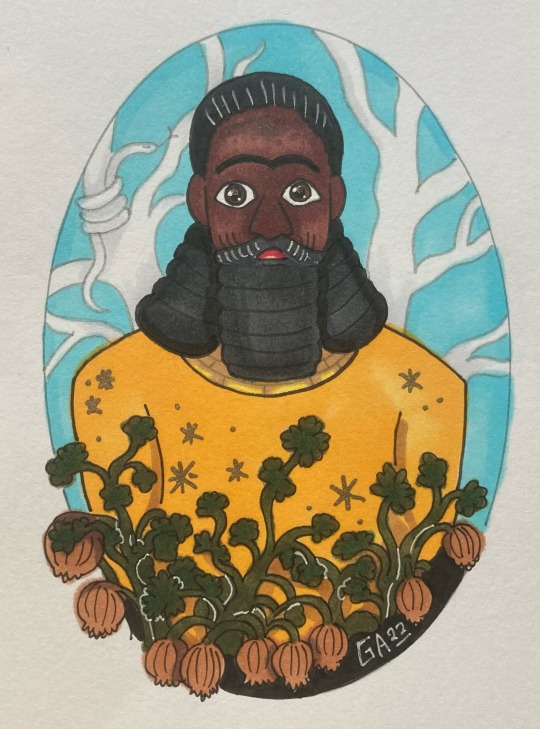
Day 7: Abu
The next member of the plant gang, probably the most mysterious. His character and function are not well known - maybe he was a plant god, maybe associated with snakes? In Enki and Ninhursag where he is born from Enki’s forehead he is called king of the grasses, perhaps hinting to a plant connection.
His spouse is another curiosity, the “second Gula,” whose deal is even poorer known.
I ended up basing his design off the “worshipper statue” from Eshnunna, which is more than likely not him, but there wasn’t much else to go on.
#annunaki#mesopotamian mythology#plant gang#mythtober2022#inktober2022#now by popular vote the info will be under the cut!
21 notes
·
View notes
Text
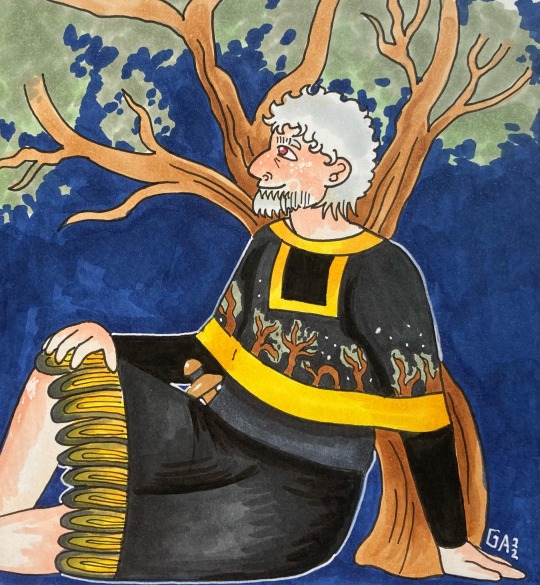
Day 27: Sar-sarbati (Bel-Sarbi)
A member of Nergal’s “underworld squad” and sometimes equated with him. He was associated with the regions Poplar trees, his name meaning “lord of the poplars”
Essentially he’s a diet Nergal.
No sources suggest he is albino, I just thought it would add to his character.
16 notes
·
View notes
Text

Day 22: (behind again oops) Sul-pa-e
A god with poorly known character. Some have proposed an association with orchards and wild animals, but he also has an affiliation with an unidentified disease, and In astronomy is connected to the planet Jupiter. His best known role would be as the husband of Ninhursag. (Hence why it’s a joke that he’s a malewife)
His name translates to something like “the youth shining forth” so I decided to be a bit ironic and make him one of the few deities who chooses to look older.
As Ninhursags consort he is the father of Lisin and Ahsgi. (and two others who I didn’t draw)
17 notes
·
View notes
Text
Content Warning: Nudity
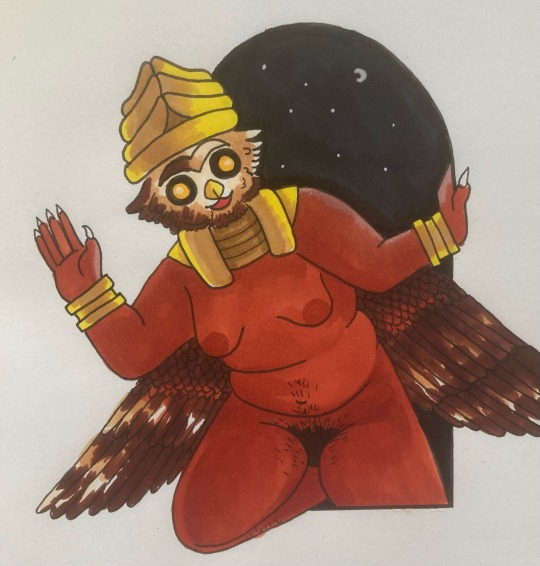
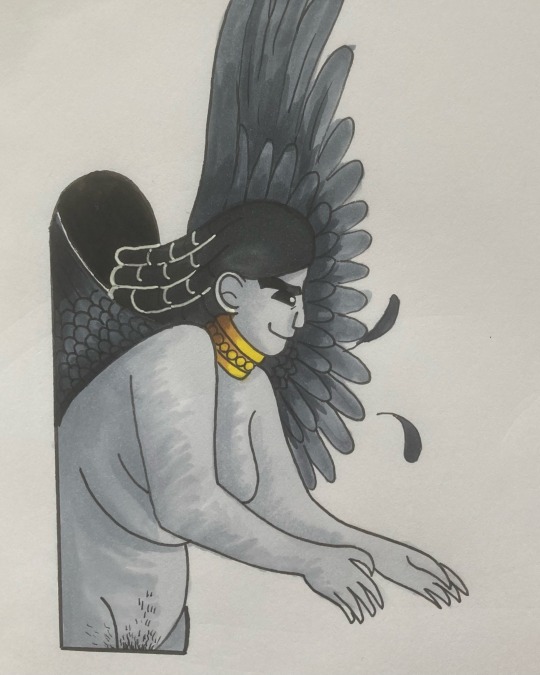
Day 19 & 20: Kilili and Abtagigi
Both are listed among the 18 messengers of Ishtar in the god list An=Anum. Kilili is equated with the name ab-ba-su-su, meaning “She who leans on the window”, paralleling Abtagigis name, which means “Retiring Through the window.”
Kilili may be the deity depicted on the burney relief (other suspects are Ishtar or Ereshkigal) and is thought to be an owl-demoness. I wrote a bit on her in her English wiki article if anyone wants to read it.
I haven’t read much about Abtagigi aside from her association with Ishtar - the stereotype of her seems to be that she was a “seductress”. I decided to make her a raven-demoness. If anyone has sources about her I’d like to read them!
#Kilili#annunaki#mesopotamian mythology#sumerian mythology#inktober2022#mythtober2022#uhhhh we’ll see if tumbr let’s me get away with this#cw: nudity
15 notes
·
View notes
Text
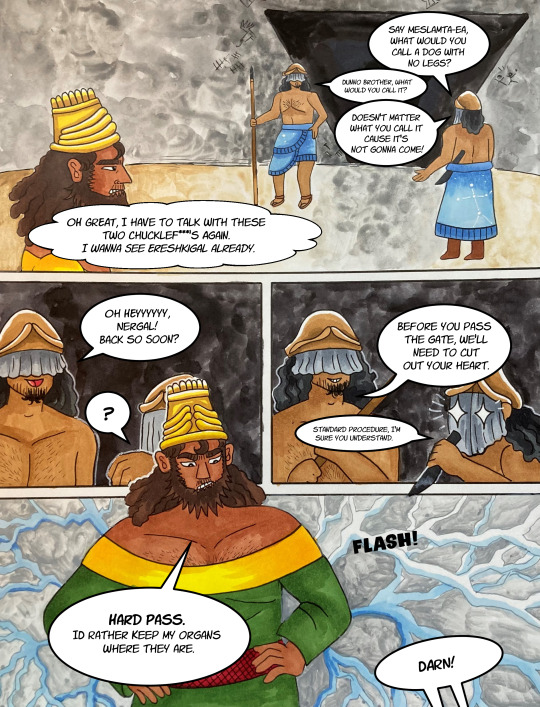
Days 29 & 30: Lugal-irra and Meslamta-ea
Lugal-Irra and Meslamta-ea are twin gods who stand at the gate of the underworld. They are also ritually associated with entrances, with small statues of them being put in gates or buried under doorways. I’ve read a few things that suggest they also cut those who passed down to the underworld (taking out a heart or cutting them into pieces). They are also connected to the constellation Gemini. Meslamta-ea was closely associated with and syncretized with Nergal. (that name is among his titles)
This is an old drawing from my Ill fated Nergal and Ereshkigal comic - I don’t think I’ll ever return to the project, but I do think some parts of it were pretty funny. In that I was planning to have these two appear several times, their deal is that they are sort of incompetent and silly and spend most of their time messing around and not doing their jobs.
19 notes
·
View notes